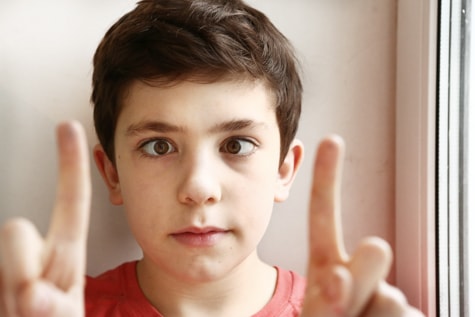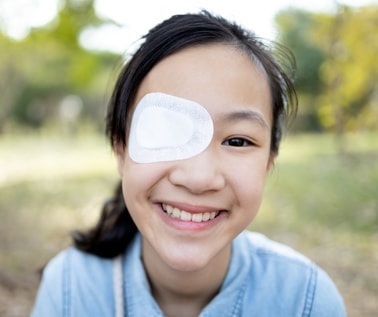Childhood Eye Problems
Pediatric ophthalmologists specialize in the medical and surgical care of children who have childhood eye disorders or symptoms of them. There are many common eye problems in kids, or signs of eye problems in children to look out for. Monitoring any eye pain in children and staying well-informed of tactics for eye safety in children are important pieces of ensuring your child’s vision is protected in the years to come. Watching for warning signs and consulting a doctor at the first sign of a problem can many times help detect an eye problem in your child at a younger age.
Many parents ask, “can children’s eyesight improve?". Depending on the reason for decreased vision in a child, there are many different ways to improve your child’s eyesight. Examination and follow-up with your child’s eye doctor or pediatric ophthalmologist will help to best determine a treatment plan.
Amblyopia, also known as “lazy eye” in children
 What is a "lazy eye"? How does a person get a "lazy eye"? Amblyopia in children, also known as “lazy eye”, is reduced vision in an eye. The condition is most often caused by a misalignment of a child’s eyes (strabismus) but can also be the result of one eye focusing better than the other. In both examples, one eye can become stronger than the other and the weaker eye is used less, or eventually not much at all. Generally, there is no immediate eye pain in children with this condition.
What is a "lazy eye"? How does a person get a "lazy eye"? Amblyopia in children, also known as “lazy eye”, is reduced vision in an eye. The condition is most often caused by a misalignment of a child’s eyes (strabismus) but can also be the result of one eye focusing better than the other. In both examples, one eye can become stronger than the other and the weaker eye is used less, or eventually not much at all. Generally, there is no immediate eye pain in children with this condition.
With early diagnosis and treatment, the sight in the “lazy eye” often can be restored. The earlier an eye specialist is consulted, the better opportunity your pediatric ophthalmologist has of helping your child to restore full vision in both eyes. Treatment options for amblyopia may include eye exercises, patching, medication, glasses, or even surgery depending on the case.
At Wolfe Eye Clinic we provide you the opportunity to meet with our pediatric eye specialists and ask common questions you may have about eye problems in kids.
Pediatric Strabismus
Strabismus, commonly known as “crossed eye” is a misalignment of the eye due to muscle imbalance. The condition is commonly associated with the drifting of one or both eyes. Drifting may be subtle or more apparent and can occur in any direction. Typically, a young child with strabismus will unconsciously reject what is seen by the improperly aligned eye possibly causing the related nerve connections between their eye and brain to fail to develop. This can lead to reduction in vision in the eye - known as amblyopia, or lazy eye.
Strabismus can be present at birth or may become apparent at a later age. If parents notice crossed or wall eyes, they should seek a pediatric ophthalmologist for an examination. This appointment will rule out any other eye diseases and ensure that the strabismus can be corrected as soon as possible.
Treatment for Child Strabismus
 At your appointment, your pediatric eye specialist will discuss the best treatment method or next steps for your child. In order to improve vision, the weakened muscles in the affected eye or eyes may need to be put to work. Depending on the cause, type and severity of strabismus, that may include:
At your appointment, your pediatric eye specialist will discuss the best treatment method or next steps for your child. In order to improve vision, the weakened muscles in the affected eye or eyes may need to be put to work. Depending on the cause, type and severity of strabismus, that may include:
-
Eyeglasses or contact lenses to help eyes that are crossed due to uncorrected farsightedness
-
Patching or covering the better-seeing eye and forcing the use of the weaker eye. Medicated eye drops may be considered as an alternative to patching to temporarily blur the vision in the good eye.
-
Strabismus surgery to straighten and realign muscles in the eyes
Looking for a pediatric eye surgeon near you? Meet Dr. Bitner and learn more about our pediatric eye specialists in Iowa and the locations they serve around the state.
Astigmatism in Children
Astigmatism is a common condition that causes blurry vision, a type of refractive error. A child may experience this in one or both eyes. Typically, the cornea, the clear outer layer of the eye, is dome-shaped, like the top of a basketball. When astigmatism is present, the cornea is shaped more like a football. This changes the way light enters the eye and makes objects both near and far appear blurry.
Astigmatism is common in infants and often clears up on its own by the time a child is one year old. Children with myopia (nearsightedness), where distant objects are out of focus, or hyperopia (farsightedness) where up close objects are out of focus, are more likely to have astigmatism. Recent studies have shown that more than 25 percent of children have at least one of these common vision problems, which tend to run in families.
Children with undiagnosed astigmatism may struggle in school and with regular activities. It is important for children to have regular eye exams, starting when they are infants and throughout their school years. Typically, prescription eyeglasses or contacts can correct a child’s vision with refractive errors and help them live their life with the best view possible.
Conjunctivitis, or “Pink Eye”, in Children
Conjunctivitis, also known as pink eye, is an inflammation of the conjunctiva, which is the clear mucous membrane that covers the white part of your eye and the inside of your eyelid. Conjunctivitis forms when the conjunctiva becomes infected, usually by a virus or bacteria and can vary from a mild red irritation with watery eyes to a serious infection with impaired, or loss of vision. Viral or bacterial conjunctivitis can be very contagious, so it is important to exercise caution with your child, washing hands and toys frequently and avoiding interaction with others. Conjunctivitis in children can also be caused by an allergic reaction or a chemical irritation which usually clears up soon after the irritant is removed.
It is best to have an examination by your doctor, or eye doctor to determine the cause if the condition persists. If necessary, your primary care provider or eye doctor may refer you see a pediatric specialist at Wolfe Eye Clinic.
Pediatric eye specialists at Wolfe Eye Clinic care for children with signs of eye problems, eye disorders, and both child and adult strabismus across the state of Iowa. Wolfe Eye Clinic offers complete pediatric eye care and pediatric eye surgeons in Iowa with locations in Ankeny and Des Moines. If you’d like to request information, fill out our form, or reach out to us at (833) 474-5850.